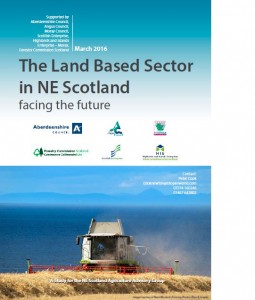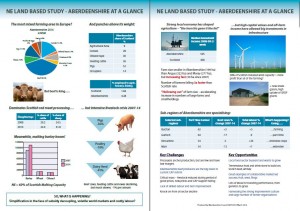The results of an in-depth study looking at the future of land-based industries such as agriculture and farm forestry in the north-east of Scotland are made public next week. (Tuesday, March 15)
The first report of its kind since 2008, “Facing the Future” identifies some of the major challenges and opportunities for the key elements of north east’s economy. Agriculture, farm woodlands, farm diversification including renewables, the input supply and processing sectors, skills and education infrastructure and the wider rural economy are considered and analysed.
The region represents only 16% of Scotland’s agricultural area, but punches well above its weight, producing a high proportion of its crops and livestock – nearly half of the national crop area, two thirds of pig production and a third of Scotland’s finishing cattle.
The multifaceted rural industry faces a number of significant challenges such as slowdown in the local oil and gas economy, exchange rate volatility, generally lower levels of Common Agricultural Policy (CAP) farm support and downward price pressures driven by the retail sector.
The North East Scotland Agriculture Advisory Group commissioned the study against this backdrop, to look at whether our land-based industries are fit for the future. It covers the local authority areas of Aberdeenshire, Moray and Angus and builds on a series of reviews of agriculture in Aberdeenshire.
The study is supported by Aberdeenshire, Angus and Moray Councils, Scottish Enterprise, HIE Moray and Forestry Commission Scotland. It identifies the development of premium products as a major opportunity, including the expansion of soft fruit production, continuing strong demand globally for Scotch whisky – and the growth of currently small-scale food and drink businesses to add value to local farm produce. Increased technical efficiency, greater adoption of new technology and best practice, capitalising on renewable energy and diversification into food tourism are all seen as further possible opportunities.
The study does however recognise the impact of global and local financial slowdown on land-based businesses’ ambitions for the region. Threats include future skills shortages, climate change and the possibility of the UK leaving the EU, and there are concerns that resources available in future for land-based training and education may not match up to industry needs.
The critical importance of the processing sector is considered in detail along with the future implications of land reform and proposals to extend Legal Rights to immovable assets in inheritance law. The key issues for the industry as a whole are identified and recommendations made for the commissioning organisations.
The study team consulted widely with industry to gather evidence and elicit views. Both the main and summary reports feature case studies which explore how land-based businesses are adapting to and preparing for the future.
Infographics have been prepared to show at-a-glance the essence of the areas of Aberdeenshire, Angus and Moray and the changes they face.
NESAAG Chairman, councillor Bill Howatson, said: “Some vital issues are highlighted in the report, not least the accelerating pace of change in farming, the role of processing, food and drink, agri-tourism, farm woodland and labour.
“I’m delighted that the North East Agriculture Advisory Group has been able to commission this study with support from partner organisations which collectively reflect the wide interest in, and commitment to this part of rural Scotland.”
Peter Cook, who led the study team, added: “Previous studies tended to show a high degree of stability – production systems and the size of farms and labour forces changed, but the headline numbers of livestock and areas of crop did not. “In the current study period there has been much more change. With falling prices and further Common Agricultural Policy reform on the way, there is scope for even more radical change over the next seven years. “So one of the key aims of the study was to help create a vision for how the sector and the businesses within it can develop and grow in future, and how they can be helped to realise their potential.”
You can view the study online, including its recommendations on what needs to be done and what is needed for the future, at: http://www.aberdeenshire.gov.uk/facingthefuture/


